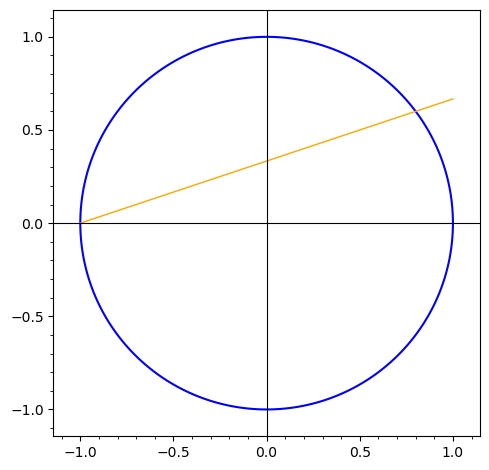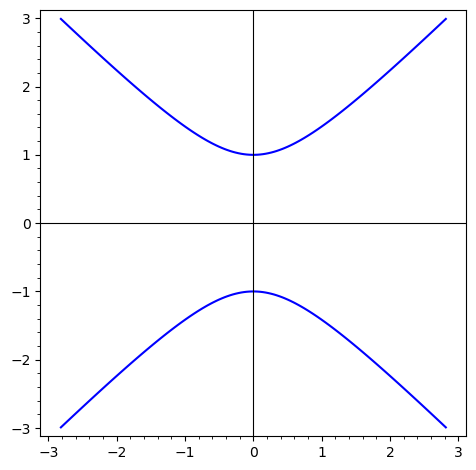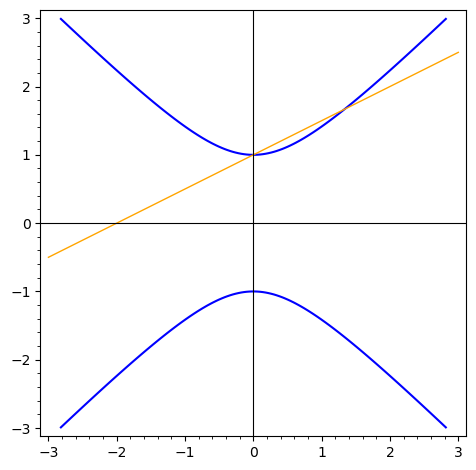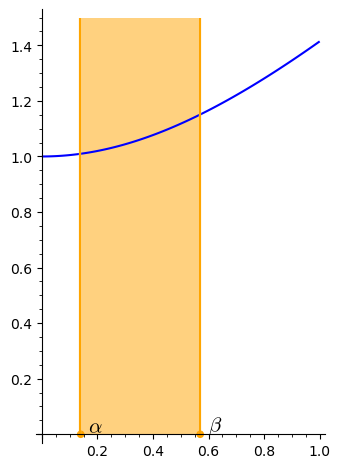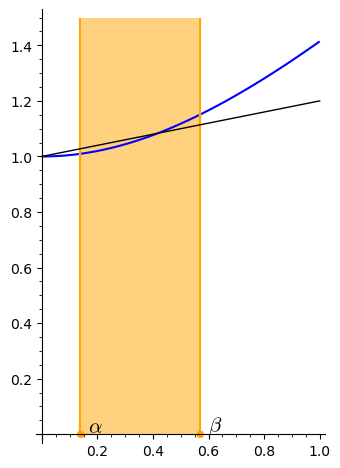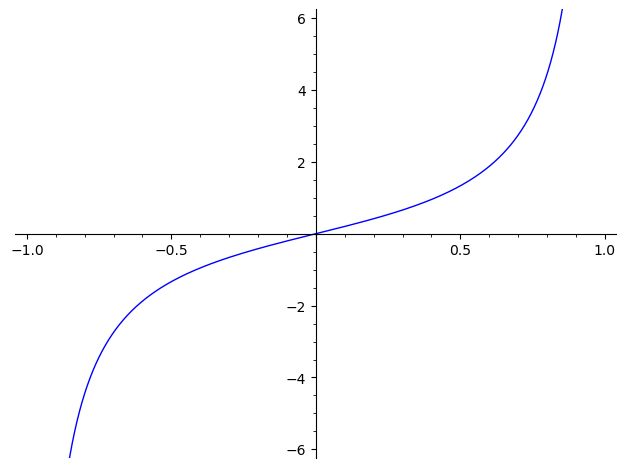Accepted: {"data":{"text/plain":"html","text/html":"With \n \\[\\alpha < \\frac{33420000}{97207759} < \\beta\\]"},"source":"sagecell"}
Accepted: {"data":{"text/plain":"html","text/html":"So \n \\[(33420000)^2 + (97207759)^2 = (102792241)^2\\]"},"source":"sagecell"}
Accepted: {"data":{"text/plain":"html","text/html":"\\[(a/b,c/b) = (x,y) = (33420000/97207759,102792241/97207759)\\]"},"source":"sagecell"}
Accepted: {"data":{"text/plain":"html","text/html":"\\[t = 1671/10000\\]"},"source":"sagecell"}
Accepted: {"data":{"application/sage-clear":{"changed":["alpha","beta"]},"text/plain":"Clear display"},"source":"sagecell"}
Accepted: {"data":{"application/sage-interact":{"new_interact_id":"b927de31-a2c8-482d-889e-fe5d32dc7331","controls":{"alpha":{"control_type":"slider","subtype":"discrete","display_value":true,"default":70,"range":[0,499],"values":["0","1/500","1/250","3/500","1/125","1/100","3/250","7/500","2/125","9/500","1/50","11/500","3/125","13/500","7/250","3/100","4/125","17/500","9/250","19/500","1/25","21/500","11/250","23/500","6/125","1/20","13/250","27/500","7/125","29/500","3/50","31/500","8/125","33/500","17/250","7/100","9/125","37/500","19/250","39/500","2/25","41/500","21/250","43/500","11/125","9/100","23/250","47/500","12/125","49/500","1/10","51/500","13/125","53/500","27/250","11/100","14/125","57/500","29/250","59/500","3/25","61/500","31/250","63/500","16/125","13/100","33/250","67/500","17/125","69/500","7/50","71/500","18/125","73/500","37/250","3/20","19/125","77/500","39/250","79/500","4/25","81/500","41/250","83/500","21/125","17/100","43/250","87/500","22/125","89/500","9/50","91/500","23/125","93/500","47/250","19/100","24/125","97/500","49/250","99/500","1/5","101/500","51/250","103/500","26/125","21/100","53/250","107/500","27/125","109/500","11/50","111/500","28/125","113/500","57/250","23/100","29/125","117/500","59/250","119/500","6/25","121/500","61/250","123/500","31/125","1/4","63/250","127/500","32/125","129/500","13/50","131/500","33/125","133/500","67/250","27/100","34/125","137/500","69/250","139/500","7/25","141/500","71/250","143/500","36/125","29/100","73/250","147/500","37/125","149/500","3/10","151/500","38/125","153/500","77/250","31/100","39/125","157/500","79/250","159/500","8/25","161/500","81/250","163/500","41/125","33/100","83/250","167/500","42/125","169/500","17/50","171/500","43/125","173/500","87/250","7/20","44/125","177/500","89/250","179/500","9/25","181/500","91/250","183/500","46/125","37/100","93/250","187/500","47/125","189/500","19/50","191/500","48/125","193/500","97/250","39/100","49/125","197/500","99/250","199/500","2/5","201/500","101/250","203/500","51/125","41/100","103/250","207/500","52/125","209/500","21/50","211/500","53/125","213/500","107/250","43/100","54/125","217/500","109/250","219/500","11/25","221/500","111/250","223/500","56/125","9/20","113/250","227/500","57/125","229/500","23/50","231/500","58/125","233/500","117/250","47/100","59/125","237/500","119/250","239/500","12/25","241/500","121/250","243/500","61/125","49/100","123/250","247/500","62/125","249/500","501/1000","503/1000","101/200","507/1000","509/1000","511/1000","513/1000","103/200","517/1000","519/1000","521/1000","523/1000","21/40","527/1000","529/1000","531/1000","533/1000","107/200","537/1000","539/1000","541/1000","543/1000","109/200","547/1000","549/1000","551/1000","553/1000","111/200","557/1000","559/1000","561/1000","563/1000","113/200","567/1000","569/1000","571/1000","573/1000","23/40","577/1000","579/1000","581/1000","583/1000","117/200","587/1000","589/1000","591/1000","593/1000","119/200","597/1000","599/1000","601/1000","603/1000","121/200","607/1000","609/1000","611/1000","613/1000","123/200","617/1000","619/1000","621/1000","623/1000","5/8","627/1000","629/1000","631/1000","633/1000","127/200","637/1000","639/1000","641/1000","643/1000","129/200","647/1000","649/1000","651/1000","653/1000","131/200","657/1000","659/1000","661/1000","663/1000","133/200","667/1000","669/1000","671/1000","673/1000","27/40","677/1000","679/1000","681/1000","683/1000","137/200","687/1000","689/1000","691/1000","693/1000","139/200","697/1000","699/1000","701/1000","703/1000","141/200","707/1000","709/1000","711/1000","713/1000","143/200","717/1000","719/1000","721/1000","723/1000","29/40","727/1000","729/1000","731/1000","733/1000","147/200","737/1000","739/1000","741/1000","743/1000","149/200","747/1000","749/1000","751/1000","753/1000","151/200","757/1000","759/1000","761/1000","763/1000","153/200","767/1000","769/1000","771/1000","773/1000","31/40","777/1000","779/1000","781/1000","783/1000","157/200","787/1000","789/1000","791/1000","793/1000","159/200","797/1000","799/1000","801/1000","803/1000","161/200","807/1000","809/1000","811/1000","813/1000","163/200","817/1000","819/1000","821/1000","823/1000","33/40","827/1000","829/1000","831/1000","833/1000","167/200","837/1000","839/1000","841/1000","843/1000","169/200","847/1000","849/1000","851/1000","853/1000","171/200","857/1000","859/1000","861/1000","863/1000","173/200","867/1000","869/1000","871/1000","873/1000","7/8","877/1000","879/1000","881/1000","883/1000","177/200","887/1000","889/1000","891/1000","893/1000","179/200","897/1000","899/1000","901/1000","903/1000","181/200","907/1000","909/1000","911/1000","913/1000","183/200","917/1000","919/1000","921/1000","923/1000","37/40","927/1000","929/1000","931/1000","933/1000","187/200","937/1000","939/1000","941/1000","943/1000","189/200","947/1000","949/1000","951/1000","953/1000","191/200","957/1000","959/1000","961/1000","963/1000","193/200","967/1000","969/1000","971/1000","973/1000","39/40","977/1000","979/1000","981/1000","983/1000","197/200","987/1000","989/1000","991/1000","993/1000","199/200","997/1000","999/1000"],"step":1,"raw":true,"label":"$\\alpha$","update":true},"beta":{"control_type":"slider","subtype":"discrete","display_value":true,"default":284,"range":[0,499],"values":["0","1/500","1/250","3/500","1/125","1/100","3/250","7/500","2/125","9/500","1/50","11/500","3/125","13/500","7/250","3/100","4/125","17/500","9/250","19/500","1/25","21/500","11/250","23/500","6/125","1/20","13/250","27/500","7/125","29/500","3/50","31/500","8/125","33/500","17/250","7/100","9/125","37/500","19/250","39/500","2/25","41/500","21/250","43/500","11/125","9/100","23/250","47/500","12/125","49/500","1/10","51/500","13/125","53/500","27/250","11/100","14/125","57/500","29/250","59/500","3/25","61/500","31/250","63/500","16/125","13/100","33/250","67/500","17/125","69/500","7/50","71/500","18/125","73/500","37/250","3/20","19/125","77/500","39/250","79/500","4/25","81/500","41/250","83/500","21/125","17/100","43/250","87/500","22/125","89/500","9/50","91/500","23/125","93/500","47/250","19/100","24/125","97/500","49/250","99/500","1/5","101/500","51/250","103/500","26/125","21/100","53/250","107/500","27/125","109/500","11/50","111/500","28/125","113/500","57/250","23/100","29/125","117/500","59/250","119/500","6/25","121/500","61/250","123/500","31/125","1/4","63/250","127/500","32/125","129/500","13/50","131/500","33/125","133/500","67/250","27/100","34/125","137/500","69/250","139/500","7/25","141/500","71/250","143/500","36/125","29/100","73/250","147/500","37/125","149/500","3/10","151/500","38/125","153/500","77/250","31/100","39/125","157/500","79/250","159/500","8/25","161/500","81/250","163/500","41/125","33/100","83/250","167/500","42/125","169/500","17/50","171/500","43/125","173/500","87/250","7/20","44/125","177/500","89/250","179/500","9/25","181/500","91/250","183/500","46/125","37/100","93/250","187/500","47/125","189/500","19/50","191/500","48/125","193/500","97/250","39/100","49/125","197/500","99/250","199/500","2/5","201/500","101/250","203/500","51/125","41/100","103/250","207/500","52/125","209/500","21/50","211/500","53/125","213/500","107/250","43/100","54/125","217/500","109/250","219/500","11/25","221/500","111/250","223/500","56/125","9/20","113/250","227/500","57/125","229/500","23/50","231/500","58/125","233/500","117/250","47/100","59/125","237/500","119/250","239/500","12/25","241/500","121/250","243/500","61/125","49/100","123/250","247/500","62/125","249/500","501/1000","503/1000","101/200","507/1000","509/1000","511/1000","513/1000","103/200","517/1000","519/1000","521/1000","523/1000","21/40","527/1000","529/1000","531/1000","533/1000","107/200","537/1000","539/1000","541/1000","543/1000","109/200","547/1000","549/1000","551/1000","553/1000","111/200","557/1000","559/1000","561/1000","563/1000","113/200","567/1000","569/1000","571/1000","573/1000","23/40","577/1000","579/1000","581/1000","583/1000","117/200","587/1000","589/1000","591/1000","593/1000","119/200","597/1000","599/1000","601/1000","603/1000","121/200","607/1000","609/1000","611/1000","613/1000","123/200","617/1000","619/1000","621/1000","623/1000","5/8","627/1000","629/1000","631/1000","633/1000","127/200","637/1000","639/1000","641/1000","643/1000","129/200","647/1000","649/1000","651/1000","653/1000","131/200","657/1000","659/1000","661/1000","663/1000","133/200","667/1000","669/1000","671/1000","673/1000","27/40","677/1000","679/1000","681/1000","683/1000","137/200","687/1000","689/1000","691/1000","693/1000","139/200","697/1000","699/1000","701/1000","703/1000","141/200","707/1000","709/1000","711/1000","713/1000","143/200","717/1000","719/1000","721/1000","723/1000","29/40","727/1000","729/1000","731/1000","733/1000","147/200","737/1000","739/1000","741/1000","743/1000","149/200","747/1000","749/1000","751/1000","753/1000","151/200","757/1000","759/1000","761/1000","763/1000","153/200","767/1000","769/1000","771/1000","773/1000","31/40","777/1000","779/1000","781/1000","783/1000","157/200","787/1000","789/1000","791/1000","793/1000","159/200","797/1000","799/1000","801/1000","803/1000","161/200","807/1000","809/1000","811/1000","813/1000","163/200","817/1000","819/1000","821/1000","823/1000","33/40","827/1000","829/1000","831/1000","833/1000","167/200","837/1000","839/1000","841/1000","843/1000","169/200","847/1000","849/1000","851/1000","853/1000","171/200","857/1000","859/1000","861/1000","863/1000","173/200","867/1000","869/1000","871/1000","873/1000","7/8","877/1000","879/1000","881/1000","883/1000","177/200","887/1000","889/1000","891/1000","893/1000","179/200","897/1000","899/1000","901/1000","903/1000","181/200","907/1000","909/1000","911/1000","913/1000","183/200","917/1000","919/1000","921/1000","923/1000","37/40","927/1000","929/1000","931/1000","933/1000","187/200","937/1000","939/1000","941/1000","943/1000","189/200","947/1000","949/1000","951/1000","953/1000","191/200","957/1000","959/1000","961/1000","963/1000","193/200","967/1000","969/1000","971/1000","973/1000","39/40","977/1000","979/1000","981/1000","983/1000","197/200","987/1000","989/1000","991/1000","993/1000","199/200","997/1000","999/1000"],"step":1,"raw":true,"label":"$\\beta$","update":true}},"layout":[[["alpha",1]],[["beta",1]],[["_output",1]]],"locations":null,"readonly":false},"text/plain":"Sage Interact"},"source":"sagecell"}
Messages
